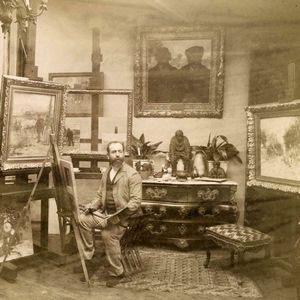Jean Francois Raffaelli Biography

Raffaelli
| Born | 1850 - 1924 |
| Birthplace | Paris, France |
| Style | Impressionist |
Jean Francois Raffaelli (1850-1924) was born and died in Paris, whose elegant mansions and down trodden souls became the subjects of his wide-ranging artwork.
Raffaelli grew up learning to sing and act, but at age of twenty he began to paint and was an immediate success. Ironically, his only formal training (with the accomplished painter Gerome) occurred after he won acclaim in 1870, and lasted only a few months.
Author Emile Zola became one of his early admirers, but he did not fare as well with some of his fellow artists. Although his style was clearly different from most of the impressionist painters of the era, Raffaelli was invited by Edgar Degas to participate in the major Paris impressionist salons of 1880 and ’81. Indeed, he had more paintings in the 1881 show than any other artist.
After receiving much critical attention and praise, Gaugin and Guillamin both issued a public declaration that if Raffaelli were included in the 1882 exhibition, they would not show their work. History may have treated Raffaelli much differently had this not taken place!
Many modern critics find Raffaelli’s subject matter as interesting today as it was during his lifetime. His philosophical bent and naturalistic tendencies can be interpreted to show a highly evolved and futuristic thinker. His observations of the absinthe drinkers and rag-pickers, chiffonnières as they were dubbed at the time, are still extremely poignant.
He was an anthropologist of sorts. He documented various aspects of a changing reality. Unlike most other artists who were observing landscapes and city streets, Raffaelli noted the effects of the changing urban landscapes had on people’s lives. Where there had been farms, there were now urban developments and factories. The Chiffonnière who may have been a tenant farmer or even a small landowner, was now scavenging rags and then sold to be recycled into sacks or paper. He keenly portrayed the underside of the prosperity gained from the industrial revolution.
At the height of his career in the 1890s, his works enjoyed even greater acceptance and brought him increased prosperity, evidenced by his light-hearted scenes of Parisian monuments and mansions and the so-called carriage trade.
By the early 1900s his primary work was printmaking in color. In the 1890s he had co-founded the French Society of Color Etching with Mary Cassatt and Camille Pissarro. He introduced a new technique in printmaking whereby up to five plates were used to create a drypoint etching.
Raffaelli died in 1924 after a long and illustrious career. His paintings hang today in major museums throughout the world, reminding us of his tremendous originality.

